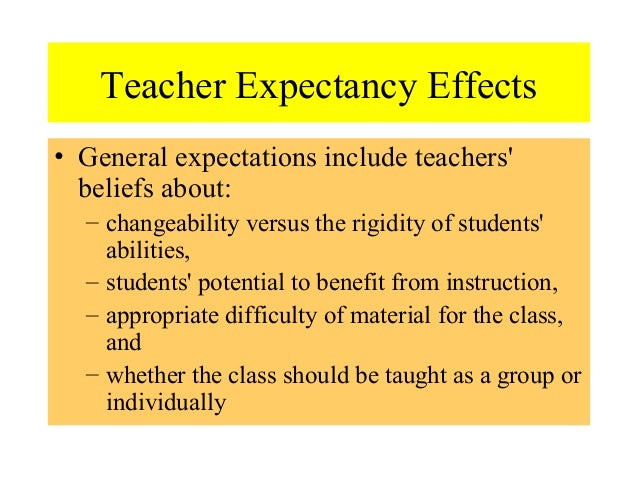Have you ever considered how a simple expectation can shape a person’s reality? Imagine a classroom where a teacher, unknowingly, harbors different expectations for two students. One student, deemed “gifted”, receives extra attention, encouragement, and challenging assignments, while the other, labeled “average,” is given less attention and simpler tasks. What if these expectations, even if subconscious, drastically influence the students’ academic performance? This is the intriguing phenomenon known as the teacher expectancy effect, a concept deeply rooted in sociology.

Image: www.oecd-ilibrary.org
The teacher expectancy effect, also known as the Pygmalion effect, is a powerful illustration of how our beliefs, especially those held by authority figures, can significantly impact individual performance, particularly in educational settings. It essentially describes how a teacher’s expectations about a student’s academic abilities can directly influence the student’s actual achievement. This effect goes beyond mere wishful thinking; it delves into the intricate interplay of social interaction, perception, and behavior.
Unraveling the Social Dynamics of Expectations
The roots of the teacher expectancy effect can be traced back to the 1960s, with the groundbreaking work of Robert Rosenthal and Lenore Jacobson. Their famous study, conducted in an elementary school, demonstrated the dramatic impact of teacher expectations on students’ intellectual growth. The researchers randomly selected students and informed teachers that these students were “bloomers” – destined to make significant academic progress. Interestingly, these “bloomers” were chosen arbitrarily, having no inherent superior abilities.
What happened next is fascinating. The students labeled as “bloomers” actually outperformed their peers in standardized tests over the academic year. This phenomenon, later dubbed the Pygmalion effect after the Greek myth where a sculptor falls in love with his own creation, highlighted the powerful influence of teacher expectations.
The Mechanisms Behind the Teacher Expectancy Effect
While the exact mechanisms behind this effect are still being explored, researchers have identified several key factors that contribute:
-
Self-Fulfilling Prophecy: The teacher’s expectations, whether conscious or unconscious, influence their behavior towards the student. They might provide more opportunities, praise, and encouragement to students they believe are “capable,” inadvertently creating a favorable learning environment for them. In contrast, students labeled as “less capable” might receive fewer challenges, less attention, and potentially even negative feedback, hindering their progress.
-
Nonverbal Cues: Teachers communicate their expectations through subtle cues – body language, tone of voice, and facial expressions. These non-verbal cues, even if unintentional, can send powerful messages to students about their abilities. A teacher who smiles more frequently at a student they expect to succeed might unwittingly create a warmer and more encouraging atmosphere.
-
Differential Treatment: The way teachers interact with students can vary based on their expectations. A teacher might call on a student they deem capable more often, offer more elaborate explanations, and even provide more time for them to answer questions. This differential treatment can create a cycle where students who receive more attention and opportunities outperform those who don’t.
Beyond the Classroom: Applications of the Teacher Expectancy Effect
The teacher expectancy effect extends far beyond the walls of a classroom. It has profound implications for various social settings, influencing individual behavior and performance in:
-
The Workplace: Supervisors, like teachers, can hold expectations about their employees’ abilities. Individuals perceived as “high-potential” might receive more opportunities for growth, mentorship, and leadership roles, while others may face limited career advancement.
-
The Legal System: Studies have shown that judges’ expectations about a defendant’s culpability can influence their sentencing decisions. This suggests that unconscious biases held by authority figures can play a significant role in shaping the course of justice.
-
Healthcare: Physicians’ expectations about a patient’s prognosis can impact their treatment approach and the patient’s response to therapy. This underscores the importance of maintaining a positive and hopeful attitude even in challenging medical situations.

Image: www.slideshare.net
Mitigating Bias and Fostering Inclusive Environments
The teacher expectancy effect serves as a stark reminder of the power of our expectations, showcasing how subconscious biases can influence our actions and inadvertently reinforce existing inequalities. However, understanding this phenomenon also empowers us to create more inclusive and equitable learning and work environments.
-
Self-Awareness and Training: Educators, professionals, and leaders can benefit from training programs that promote self-awareness, helping them recognize and challenge their own implicit biases. This crucial step can promote a more objective and equitable approach to interacting with others.
-
Data-Driven Assessment: Adopting a data-driven approach to evaluating student performance can help minimize subjective biases. By focusing on objective metrics rather than relying solely on personal impressions, we can create a fairer system for assessing progress.
-
Creating a Culture of Growth: Cultivating a culture that emphasizes growth and learning for everyone can help dismantle the rigid categories of “gifted” or “average.” Instead of labeling students or employees, we can focus on identifying and nurturing individual strengths and talents.
Teacher Expectancy Effect Sociology
Embracing the Potential: Moving Beyond Expectations
The teacher expectancy effect offers valuable insights into the social dynamics that shape our reality. While expectations can have both positive and negative impacts, by acknowledging their influence and actively seeking to mitigate the negative effects of bias, we can create societies where everyone has the opportunity to reach their full potential. It’s a call to action to become more mindful, empathetic, and inclusive in our interactions, recognizing that our beliefs have the power to shape the future for ourselves and those around us.
The teacher expectancy effect, with its intricate social and psychological dimensions, is a testament to the power of perception. By understanding its mechanisms and implications, we can move beyond limiting expectations and work towards constructing a more equitable and just world for everyone.






